engine FIAT IDEA 2010 1.G Repair Manual
[x] Cancel search | Manufacturer: FIAT, Model Year: 2010, Model line: IDEA, Model: FIAT IDEA 2010 1.GPages: 210, PDF Size: 4.4 MB
Page 173 of 210
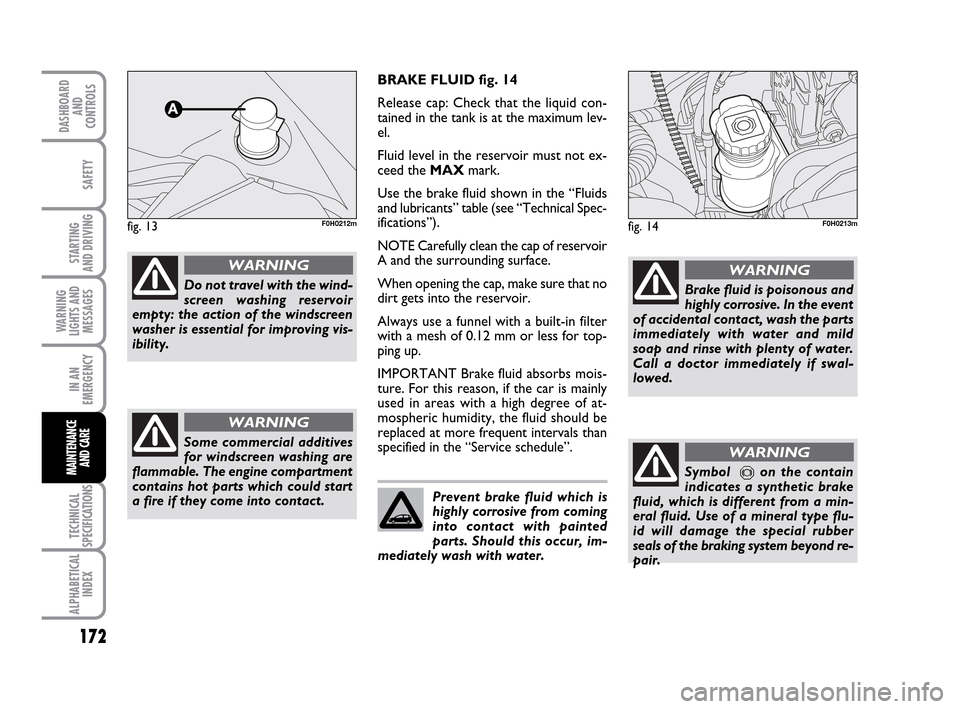
172
STARTING
AND DRIVING
IN AN
EMERGENCY
TECHNICAL
SPECIFICATIONS
ALPHABETICAL
INDEX
DASHBOARD
AND
CONTROLS
SAFETY
WARNING
LIGHTS AND
MESSAGES
MAINTENANCE
AND CARE
BRAKE FLUID fig. 14
Release cap: Check that the liquid con-
tained in the tank is at the maximum lev-
el.
Fluid level in the reservoir must not ex-
ceed the MAXmark.
Use the brake fluid shown in the “Fluids
and lubricants” table (see “Technical Spec-
ifications”).
NOTE Carefully clean the cap of reservoir
A and the surrounding surface.
When opening the cap, make sure that no
dirt gets into the reservoir.
Always use a funnel with a built-in filter
with a mesh of 0.12 mm or less for top-
ping up.
IMPORTANT Brake fluid absorbs mois-
ture. For this reason, if the car is mainly
used in areas with a high degree of at-
mospheric humidity, the fluid should be
replaced at more frequent intervals than
specified in the “Service schedule”.
fig. 14F0H0213m
Brake fluid is poisonous and
highly corrosive. In the event
of accidental contact, wash the parts
immediately with water and mild
soap and rinse with plenty of water.
Call a doctor immediately if swal-
lowed.
WARNING
Symbol πon the contain
indicates a synthetic brake
fluid, which is different from a min-
eral fluid. Use of a mineral type flu-
id will damage the special rubber
seals of the braking system beyond re-
pair.
WARNING
Prevent brake fluid which is
highly corrosive from coming
into contact with painted
parts. Should this occur, im-
mediately wash with water.
Do not travel with the wind-
screen washing reservoir
empty: the action of the windscreen
washer is essential for improving vis-
ibility.
WARNING
Some commercial additives
for windscreen washing are
flammable. The engine compartment
contains hot parts which could start
a fire if they come into contact.
WARNING
fig. 13F0H0212m
161-180 LUM IDEA GB 2 ed.qxd 14-01-2010 13:52 Pagina 172
Page 174 of 210
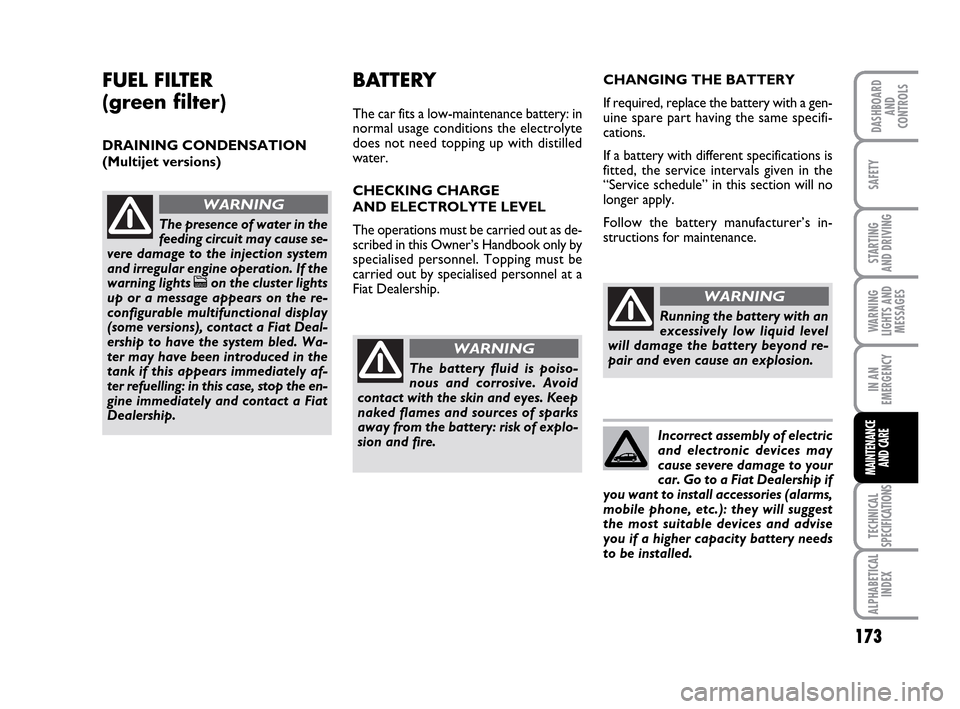
173
STARTING
AND DRIVING
IN AN
EMERGENCY
TECHNICAL
SPECIFICATIONS
ALPHABETICAL
INDEX
DASHBOARD
AND
CONTROLS
SAFETY
WARNING
LIGHTS AND
MESSAGES
MAINTENANCE
AND CARE
FUEL FILTER
(green filter)
DRAINING CONDENSATION
(Multijet versions)
The presence of water in the
feeding circuit may cause se-
vere damage to the injection system
and irregular engine operation. If the
warning lights
con the cluster lights
up or a message appears on the re-
configurable multifunctional display
(some versions), contact a Fiat Deal-
ership to have the system bled. Wa-
ter may have been introduced in the
tank if this appears immediately af-
ter refuelling: in this case, stop the en-
gine immediately and contact a Fiat
Dealership.
WARNING
BATTERY
The car fits a low-maintenance battery: in
normal usage conditions the electrolyte
does not need topping up with distilled
water.
CHECKING CHARGE
AND ELECTROLYTE LEVEL
The operations must be carried out as de-
scribed in this Owner’s Handbook only by
specialised personnel. Topping must be
carried out by specialised personnel at a
Fiat Dealership.
The battery fluid is poiso-
nous and corrosive. Avoid
contact with the skin and eyes. Keep
naked flames and sources of sparks
away from the battery: risk of explo-
sion and fire.
WARNING
CHANGING THE BATTERY
If required, replace the battery with a gen-
uine spare part having the same specifi-
cations.
If a battery with different specifications is
fitted, the service intervals given in the
“Service schedule” in this section will no
longer apply.
Follow the battery manufacturer’s in-
structions for maintenance.
Running the battery with an
excessively low liquid level
will damage the battery beyond re-
pair and even cause an explosion.
WARNING
Incorrect assembly of electric
and electronic devices may
cause severe damage to your
car. Go to a Fiat Dealership if
you want to install accessories (alarms,
mobile phone, etc.): they will suggest
the most suitable devices and advise
you if a higher capacity battery needs
to be installed.
161-180 LUM IDEA GB 2 ed.qxd 14-01-2010 13:53 Pagina 173
Page 175 of 210
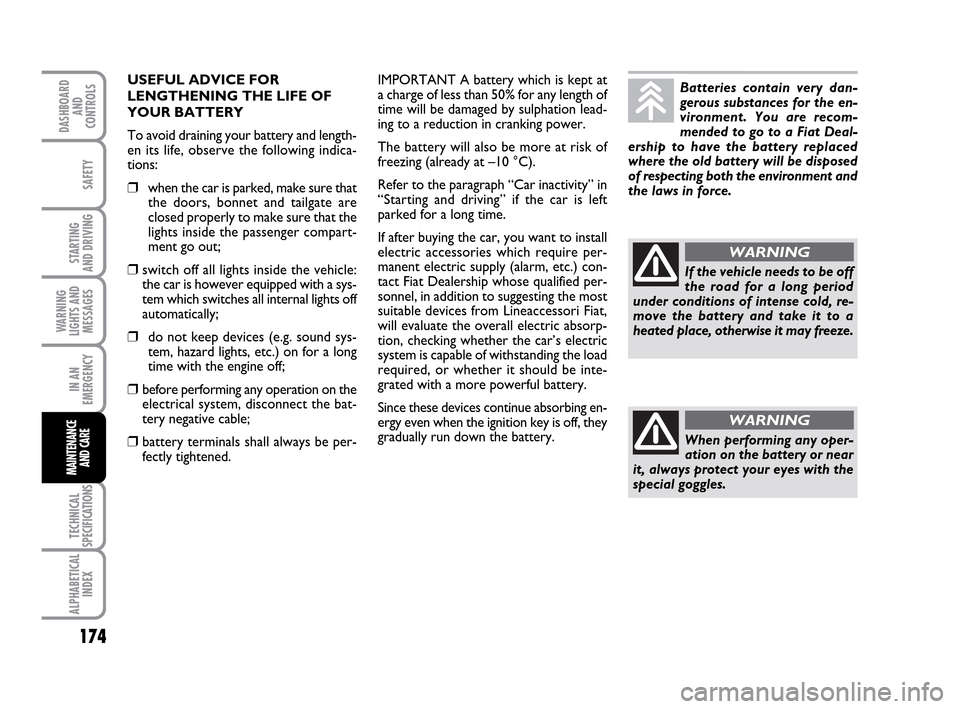
174
STARTING
AND DRIVING
IN AN
EMERGENCY
TECHNICAL
SPECIFICATIONS
ALPHABETICAL
INDEX
DASHBOARD
AND
CONTROLS
SAFETY
WARNING
LIGHTS AND
MESSAGES
MAINTENANCE
AND CARE
IMPORTANT A battery which is kept at
a charge of less than 50% for any length of
time will be damaged by sulphation lead-
ing to a reduction in cranking power.
The battery will also be more at risk of
freezing (already at –10 °C).
Refer to the paragraph “Car inactivity” in
“Starting and driving” if the car is left
parked for a long time.
If after buying the car, you want to install
electric accessories which require per-
manent electric supply (alarm, etc.) con-
tact Fiat Dealership whose qualified per-
sonnel, in addition to suggesting the most
suitable devices from Lineaccessori Fiat,
will evaluate the overall electric absorp-
tion, checking whether the car’s electric
system is capable of withstanding the load
required, or whether it should be inte-
grated with a more powerful battery.
Since these devices continue absorbing en-
ergy even when the ignition key is off, they
gradually run down the battery. USEFUL ADVICE FOR
LENGTHENING THE LIFE OF
YOUR BATTERY
To avoid draining your battery and length-
en its life, observe the following indica-
tions:
❒when the car is parked, make sure that
the doors, bonnet and tailgate are
closed properly to make sure that the
lights inside the passenger compart-
ment go out;
❒switch off all lights inside the vehicle:
the car is however equipped with a sys-
tem which switches all internal lights off
automatically;
❒do not keep devices (e.g. sound sys-
tem, hazard lights, etc.) on for a long
time with the engine off;
❒before performing any operation on the
electrical system, disconnect the bat-
tery negative cable;
❒battery terminals shall always be per-
fectly tightened.Batteries contain very dan-
gerous substances for the en-
vironment. You are recom-
mended to go to a Fiat Deal-
ership to have the battery replaced
where the old battery will be disposed
of respecting both the environment and
the laws in force.
If the vehicle needs to be off
the road for a long period
under conditions of intense cold, re-
move the battery and take it to a
heated place, otherwise it may freeze.
WARNING
When performing any oper-
ation on the battery or near
it, always protect your eyes with the
special goggles.
WARNING
161-180 LUM IDEA GB 2 ed.qxd 14-01-2010 13:53 Pagina 174
Page 179 of 210
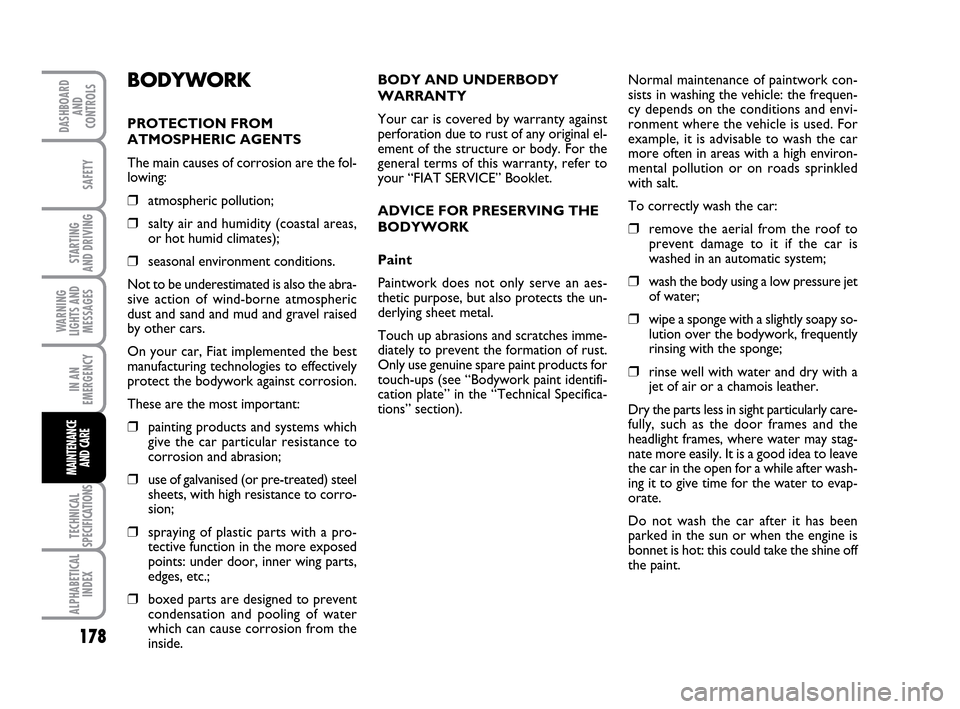
178
STARTING
AND DRIVING
IN AN
EMERGENCY
TECHNICAL
SPECIFICATIONS
ALPHABETICAL
INDEX
DASHBOARD
AND
CONTROLS
SAFETY
WARNING
LIGHTS AND
MESSAGES
MAINTENANCE
AND CARE
BODYWORK
PROTECTION FROM
ATMOSPHERIC AGENTS
The main causes of corrosion are the fol-
lowing:
❒atmospheric pollution;
❒salty air and humidity (coastal areas,
or hot humid climates);
❒seasonal environment conditions.
Not to be underestimated is also the abra-
sive action of wind-borne atmospheric
dust and sand and mud and gravel raised
by other cars.
On your car, Fiat implemented the best
manufacturing technologies to effectively
protect the bodywork against corrosion.
These are the most important:
❒painting products and systems which
give the car particular resistance to
corrosion and abrasion;
❒use of galvanised (or pre-treated) steel
sheets, with high resistance to corro-
sion;
❒spraying of plastic parts with a pro-
tective function in the more exposed
points: under door, inner wing parts,
edges, etc.;
❒boxed parts are designed to prevent
condensation and pooling of water
which can cause corrosion from the
inside.BODY AND UNDERBODY
WARRANTY
Your car is covered by warranty against
perforation due to rust of any original el-
ement of the structure or body. For the
general terms of this warranty, refer to
your “FIAT SERVICE” Booklet.
ADVICE FOR PRESERVING THE
BODYWORK
Paint
Paintwork does not only serve an aes-
thetic purpose, but also protects the un-
derlying sheet metal.
Touch up abrasions and scratches imme-
diately to prevent the formation of rust.
Only use genuine spare paint products for
touch-ups (see “Bodywork paint identifi-
cation plate” in the “Technical Specifica-
tions” section).Normal maintenance of paintwork con-
sists in washing the vehicle: the frequen-
cy depends on the conditions and envi-
ronment where the vehicle is used. For
example, it is advisable to wash the car
more often in areas with a high environ-
mental pollution or on roads sprinkled
with salt.
To correctly wash the car:
❒remove the aerial from the roof to
prevent damage to it if the car is
washed in an automatic system;
❒wash the body using a low pressure jet
of water;
❒wipe a sponge with a slightly soapy so-
lution over the bodywork, frequently
rinsing with the sponge;
❒rinse well with water and dry with a
jet of air or a chamois leather.
Dry the parts less in sight particularly care-
fully, such as the door frames and the
headlight frames, where water may stag-
nate more easily. It is a good idea to leave
the car in the open for a while after wash-
ing it to give time for the water to evap-
orate.
Do not wash the car after it has been
parked in the sun or when the engine is
bonnet is hot: this could take the shine off
the paint.
161-180 LUM IDEA GB 2 ed.qxd 14-01-2010 13:53 Pagina 178
Page 180 of 210
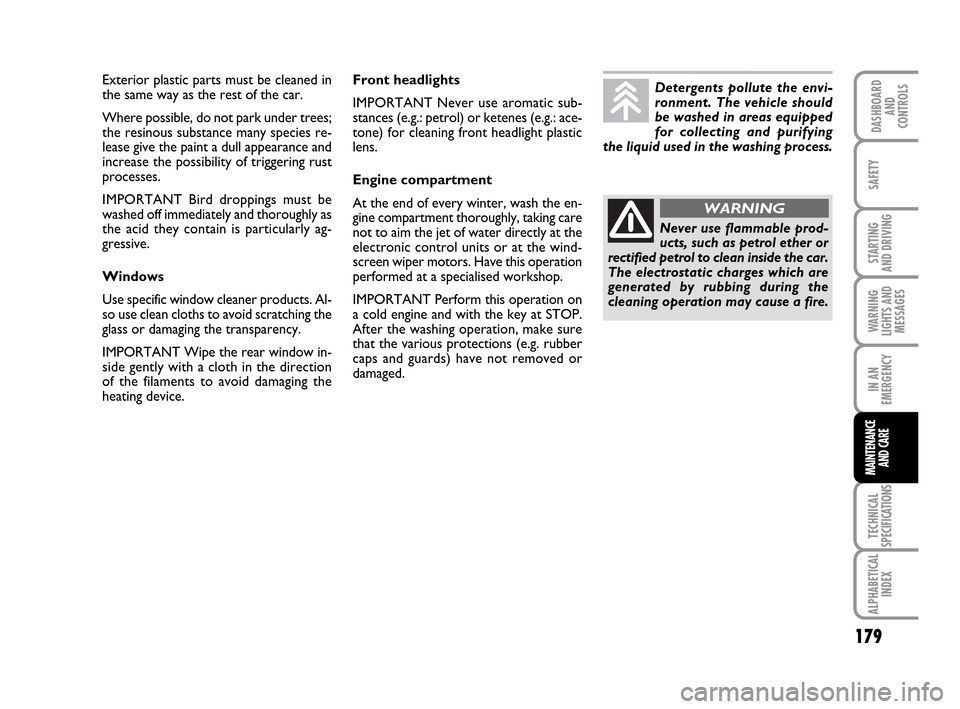
179
STARTING
AND DRIVING
IN AN
EMERGENCY
TECHNICAL
SPECIFICATIONS
ALPHABETICAL
INDEX
DASHBOARD
AND
CONTROLS
SAFETY
WARNING
LIGHTS AND
MESSAGES
MAINTENANCE
AND CARE
Exterior plastic parts must be cleaned in
the same way as the rest of the car.
Where possible, do not park under trees;
the resinous substance many species re-
lease give the paint a dull appearance and
increase the possibility of triggering rust
processes.
IMPORTANT Bird droppings must be
washed off immediately and thoroughly as
the acid they contain is particularly ag-
gressive.
Windows
Use specific window cleaner products. Al-
so use clean cloths to avoid scratching the
glass or damaging the transparency.
IMPORTANT Wipe the rear window in-
side gently with a cloth in the direction
of the filaments to avoid damaging the
heating device.Front headlights
IMPORTANT Never use aromatic sub-
stances (e.g.: petrol) or ketenes (e.g.: ace-
tone) for cleaning front headlight plastic
lens.
Engine compartment
At the end of every winter, wash the en-
gine compartment thoroughly, taking care
not to aim the jet of water directly at the
electronic control units or at the wind-
screen wiper motors. Have this operation
performed at a specialised workshop.
IMPORTANT Perform this operation on
a cold engine and with the key at STOP.
After the washing operation, make sure
that the various protections (e.g. rubber
caps and guards) have not removed or
damaged.Detergents pollute the envi-
ronment. The vehicle should
be washed in areas equipped
for collecting and purifying
the liquid used in the washing process.
Never use flammable prod-
ucts, such as petrol ether or
rectified petrol to clean inside the car.
The electrostatic charges which are
generated by rubbing during the
cleaning operation may cause a fire.
WARNING
161-180 LUM IDEA GB 2 ed.qxd 14-01-2010 13:53 Pagina 179
Page 182 of 210
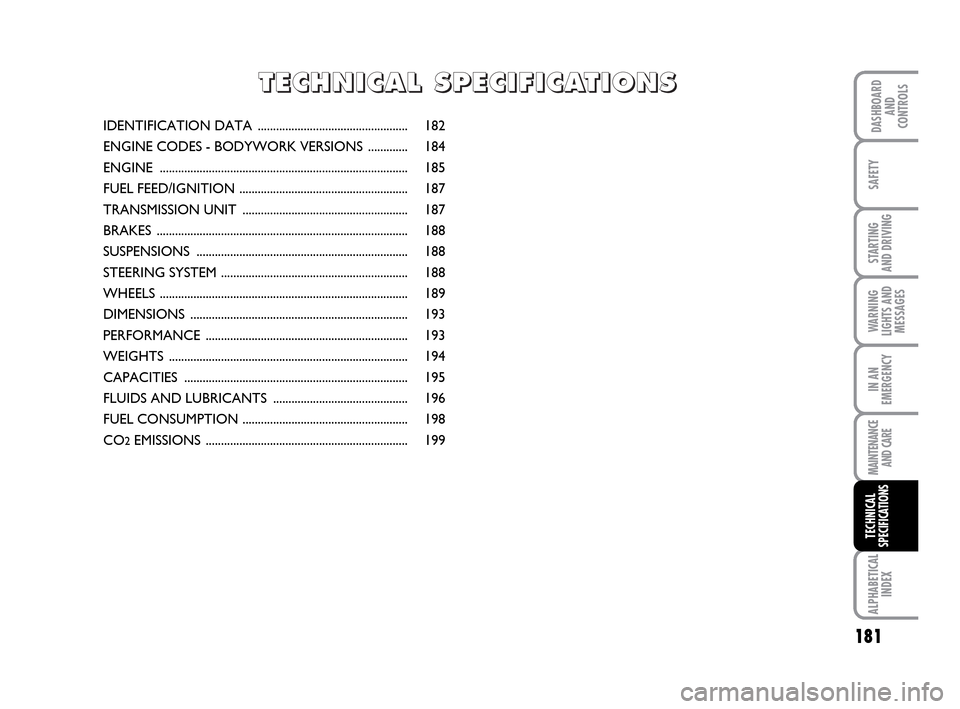
181
STARTING
AND DRIVING
IN AN
EMERGENCY
MAINTENANCE
AND CARE
ALPHABETICAL
INDEX
DASHBOARD
AND
CONTROLS
SAFETY
WARNING
LIGHTS AND
MESSAGES
TECHNICAL
SPECIFICATIONS
IDENTIFICATION DATA ................................................. 182
ENGINE CODES - BODYWORK VERSIONS ............. 184
ENGINE ................................................................................. 185
FUEL FEED/IGNITION ....................................................... 187
TRANSMISSION UNIT ...................................................... 187
BRAKES .................................................................................. 188
SUSPENSIONS ..................................................................... 188
STEERING SYSTEM ............................................................. 188
WHEELS ................................................................................. 189
DIMENSIONS ....................................................................... 193
PERFORMANCE .................................................................. 193
WEIGHTS .............................................................................. 194
CAPACITIES ......................................................................... 195
FLUIDS AND LUBRICANTS ............................................ 196
FUEL CONSUMPTION ...................................................... 198
CO
2EMISSIONS .................................................................. 199
T T
E E
C C
H H
N N
I I
C C
A A
L L
S S
P P
E E
C C
I I
F F
I I
C C
A A
T T
I I
O O
N N
S S
181-199 LUM IDEA GB 2 ed.qxd 14-01-2010 13:56 Pagina 181
Page 183 of 210
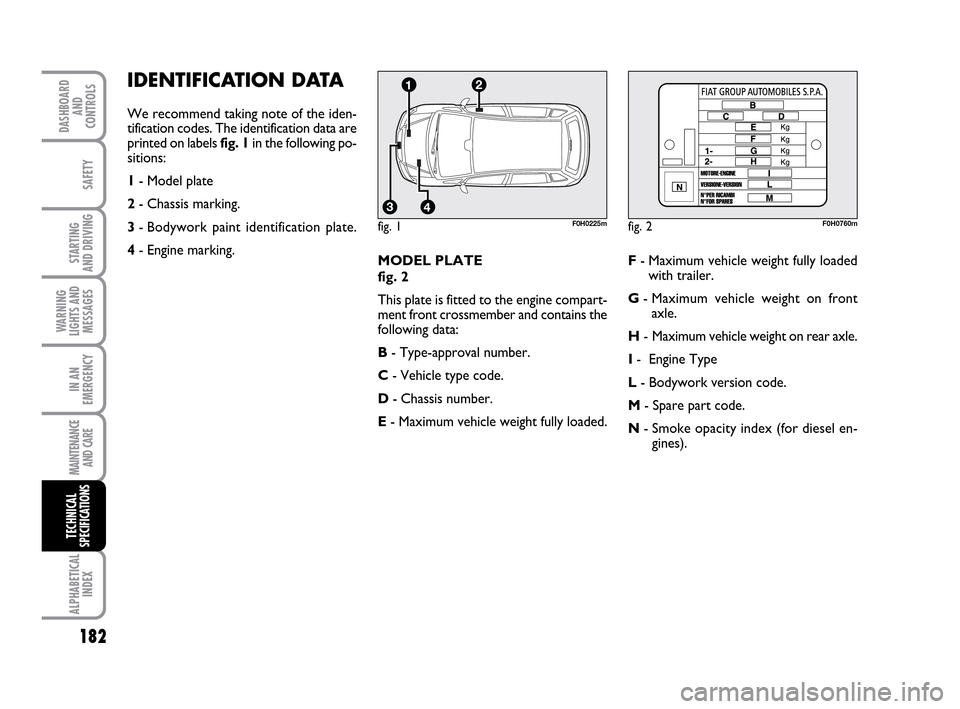
182
STARTING
AND DRIVING
MAINTENANCE
AND CARE
ALPHABETICAL
INDEX
DASHBOARD
AND
CONTROLS
SAFETY
WARNING
LIGHTS AND
MESSAGES
TECHNICAL
SPECIFICATIONS
IDENTIFICATION DATA
We recommend taking note of the iden-
tification codes. The identification data are
printed on labels fig. 1in the following po-
sitions:
1- Model plate
2- Chassis marking.
3- Bodywork paint identification plate.
4- Engine marking.
MODEL PLATE
fig. 2
This plate is fitted to the engine compart-
ment front crossmember and contains the
following data:
B- Type-approval number.
C- Vehicle type code.
D- Chassis number.
E- Maximum vehicle weight fully loaded.F- Maximum vehicle weight fully loaded
with trailer.
G- Maximum vehicle weight on front
axle.
H- Maximum vehicle weight on rear axle.
I- Engine Type
L- Bodywork version code.
M- Spare part code.
N- Smoke opacity index (for diesel en-
gines).
fig. 1
4
21
3
F0H0225mfig. 2F0H0760m
IN AN
EMERGENCY
181-199 LUM IDEA GB 2 ed.qxd 14-01-2010 13:56 Pagina 182
Page 184 of 210
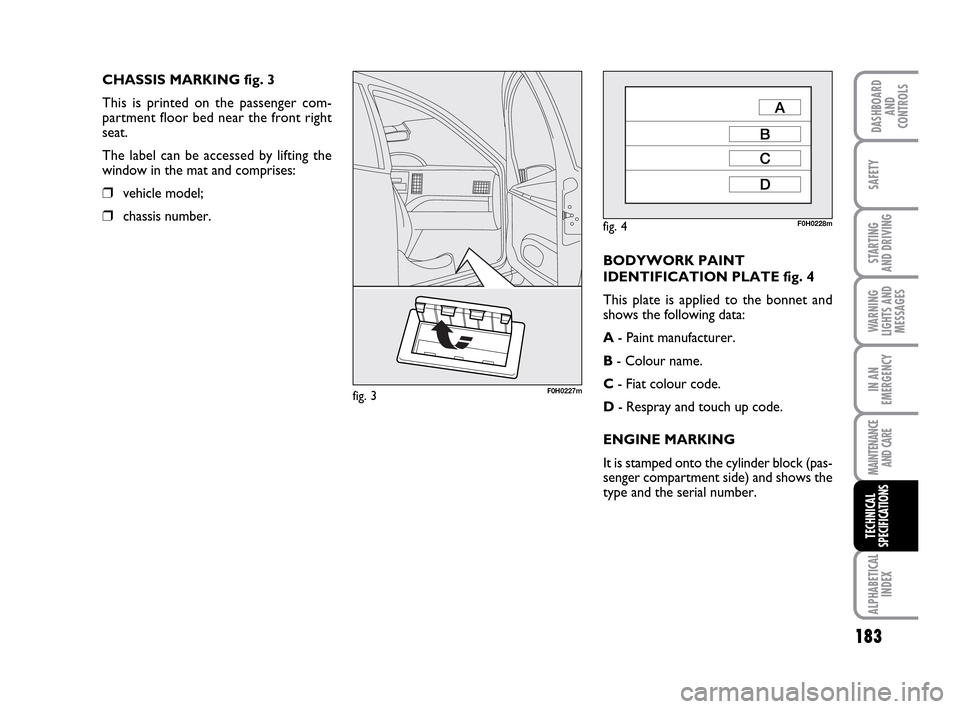
183
STARTING
AND DRIVING
IN AN
EMERGENCY
MAINTENANCE
AND CARE
ALPHABETICAL
INDEX
DASHBOARD
AND
CONTROLS
SAFETY
WARNING
LIGHTS AND
MESSAGES
TECHNICAL
SPECIFICATIONS
CHASSIS MARKING fig. 3
This is printed on the passenger com-
partment floor bed near the front right
seat.
The label can be accessed by lifting the
window in the mat and comprises:
❒vehicle model;
❒chassis number.
fig. 3F0H0227m
fig. 4F0H0228m
BODYWORK PAINT
IDENTIFICATION PLATE fig. 4
This plate is applied to the bonnet and
shows the following data:
A- Paint manufacturer.
B- Colour name.
C- Fiat colour code.
D- Respray and touch up code.
ENGINE MARKING
It is stamped onto the cylinder block (pas-
senger compartment side) and shows the
type and the serial number.
181-199 LUM IDEA GB 2 ed.qxd 14-01-2010 13:56 Pagina 183
Page 185 of 210
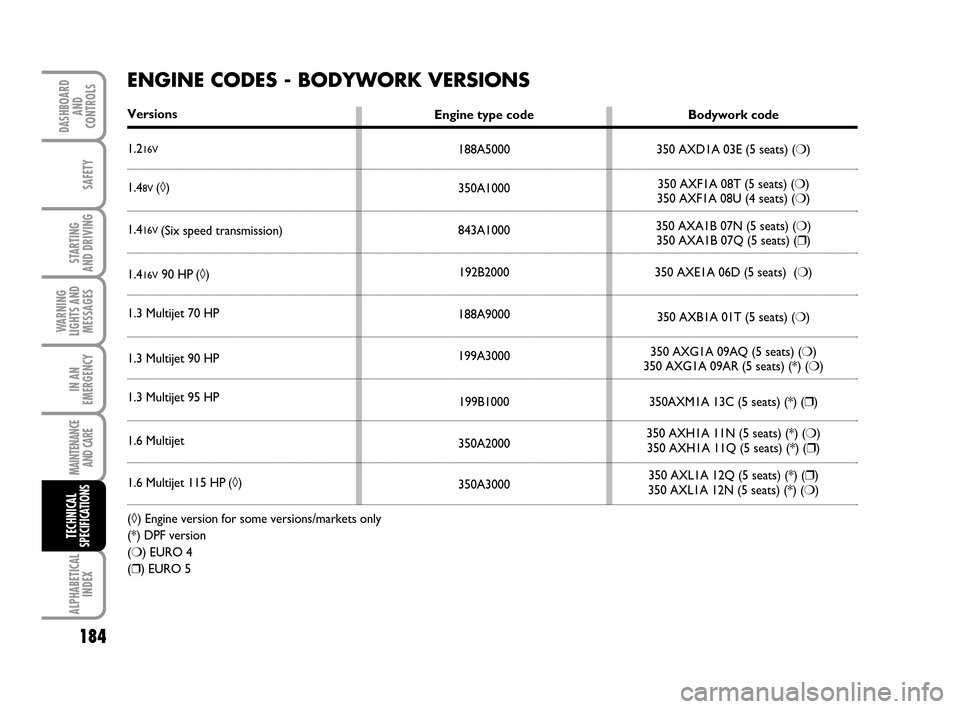
Bodywork code
350 AXD1A 03E (5 seats) (❍)
350 AXF1A 08T (5 seats) (❍)
350 AXF1A 08U (4 seats) (❍)
350 AXA1B 07N (5 seats) (❍)
350 AXA1B 07Q (5 seats) (❒)
350 AXE1A 06D (5 seats) (❍)
350 AXB1A 01T (5 seats) (❍)
350 AXG1A 09AQ (5 seats) (❍)
350 AXG1A 09AR (5 seats) (*) (❍)
350AXM1A 13C (5 seats) (*) (❒)
350 AXH1A 11N (5 seats) (*) (❍)
350 AXH1A 11Q (5 seats) (*) (❒)
350 AXL1A 12Q (5 seats) (*) (❒)
350 AXL1A 12N (5 seats) (*) (❍)Engine type code
188A5000
350A1000
843A1000
192B2000
188A9000
199A3000
199B1000
350A2000
350A3000
184
STARTING
AND DRIVING
IN AN
EMERGENCY
MAINTENANCE
AND CARE
ALPHABETICAL
INDEX
DASHBOARD
AND
CONTROLS
SAFETY
WARNING
LIGHTS AND
MESSAGES
TECHNICAL
SPECIFICATIONS
ENGINE CODES - BODYWORK VERSIONS
Versions
1.2
16V
1.48V (◊)
1.416V (Six speed transmission)
1.416V90 HP (◊)
1.3 Multijet 70 HP
1.3 Multijet 90 HP
1.3 Multijet 95 HP
1.6 Multijet
1.6 Multijet 115 HP (◊)
(◊) Engine version for some versions/markets only
(*) DPF version
(❍) EURO 4
(❒) EURO 5
181-199 LUM IDEA GB 2 ed.qxd 14-01-2010 13:56 Pagina 184
Page 186 of 210
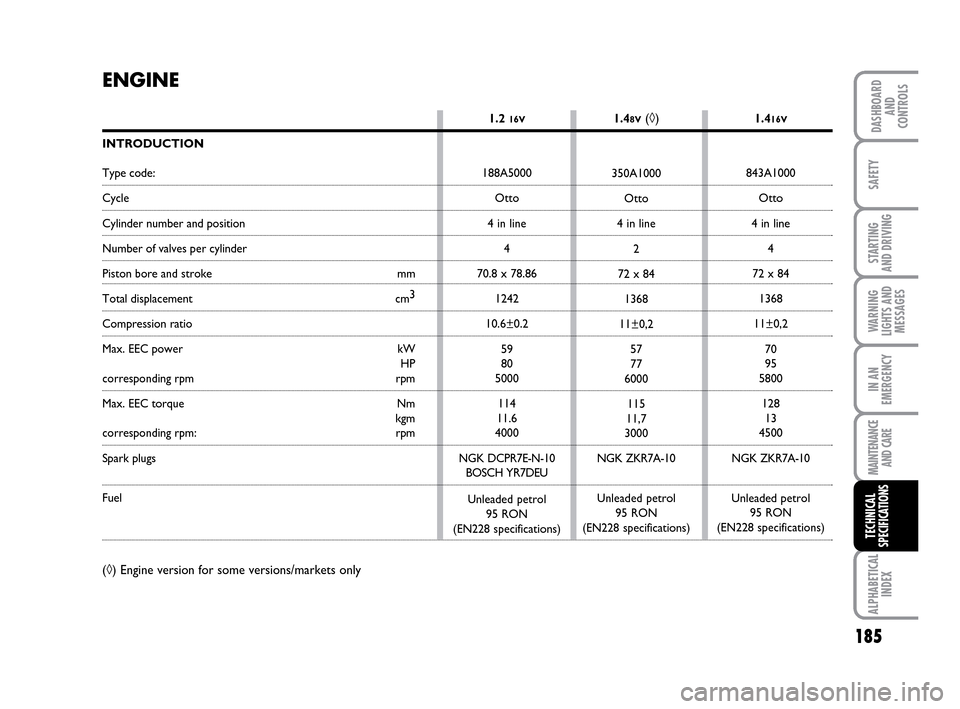
185
STARTING
AND DRIVING
IN AN
EMERGENCY
MAINTENANCE
AND CARE
ALPHABETICAL
INDEX
DASHBOARD
AND
CONTROLS
SAFETY
WARNING
LIGHTS AND
MESSAGES
TECHNICAL
SPECIFICATIONS
(◊) Engine version for some versions/markets only
ENGINE
INTRODUCTION
Type code:
Cycle
Cylinder number and position
Number of valves per cylinder
Piston bore and stroke mm
Total displacement cm3
Compression ratio
Max. EEC power kW
HP
corresponding rpm rpm
Max. EEC torque Nm
kgm
corresponding rpm: rpm
Spark plugs
Fuel
1.2 16V
188A5000
Otto
4 in line
4
70.8 x 78.86
1242
10.6±0.2
59
80
5000
114
11.6
4000
NGK DCPR7E-N-10
BOSCH YR7DEU
Unleaded petrol
95 RON
(EN228 specifications)1.4
16V
843A1000
Otto
4 in line
4
72 x 84
1368
11±0,2
70
95
5800
128
13
4500
NGK ZKR7A-10
Unleaded petrol
95 RON
(EN228 specifications) 1.4
8V(◊)
350A1000
Otto
4 in line
2
72 x 84
1368
11±0,2
57
77
6000
115
11,7
3000
NGK ZKR7A-10
Unleaded petrol
95 RON
(EN228 specifications)
181-199 LUM IDEA GB 2 ed.qxd 14-01-2010 13:56 Pagina 185